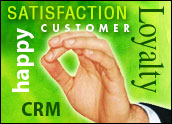
Few marketers would argue against the importance of relevant, timely, personalized marketing communications. In fact, research has consistently proven the value of personalizing marketing messages by segmentation, targeting, or one-to-one messaging. Personalized email campaigns generate two to three times higher click-through rates than mass email campaigns and twice the conversion rates. Unfortunately, when it comes to personalization and one-to-one initiatives, many marketers are constrained by the quality of customer data and an inability to centralize disparate data for analysis.
Despite the fact that 99 percent of email marketing tools have dynamic messaging capabilities where customer database fields can be automatically inserted into outbound email messaging to deliver highly personalized interactions, only 19 percent of respondents from a December 2009 Aberdeen study “Customer Analytics Leveraging Customer Data to Fulfill the One-to-One Marketing Imperative” actually leveraged these capabilities.
Data quality was the No. 1 challenge for 53 percent of all respondents, followed by a lack of tools to uncover new segments and targets with customer data (50 percent). The study classified Best-in-Class organizations as the top 20 percent of performers in return on marketing investments, annual revenue, click-through rates on email campaigns, and the marketers own indication of how much they trust their customer data.
Call to Arms
The report is a call to action for all marketers to take an active role in improving customer data.
We are inundated with insurmountable amounts of information every day: publications, blogs, newsletters, print advertising, TV, radio, email and digital personas, to name a few. The number of new channels for reaching a target audience seems to multiply each year. For marketers this leads to one unavoidable truth: Attention is a scarce commodity. Every marketer wants to rise above the noise, but how?
Best-in-Class organizations have consistently demonstrated that intimate personalized customer engagement yields the highest performance in KPIs such as annual revenue, Return on Marketing Investments (ROMI), response rates, and customer profitability. Superior business performance has become a byproduct of relevant, timely, personalized customer experiences. Share of wallet is awarded to the companies that embrace these changes and rise above noise with more engaging, personalized customer experiences.
By benchmarking Best-in-Class practices, all marketers can learn how these organizations leverage customer data to fulfill the one-to-one marketing imperative.
- Make customer data a priority in 2010. A staggering 68 percent of all respondents cited the need to improve customer data as a top three priority in their organizations in 2010. Information changes rapidly in today’s fast moving digital environment. In the blink of an eye, customer data can become outdated or inaccurate. Organizations also struggle with disparate technologies and cross-functional data silos that prevent segmentation, ROI analysis, and actionable insight.
- Start with improving the quality of existing customer data first. Existing customers remain a source of highly profitable revenue. Every organization has pre-existing customer data that can be scrubbed for accuracy and centralized for analysis. Best-in-Class organizations are increasing budget for more personalized cross-selling, up-selling and repeat purchase initiatives in 2010. These engagements also work to promote customer advocacy and customer loyalty.
- Periodically scrub the customer database on a regular basis. The Best-in-Class are three times more likely than All Other organizations to cleanse customer data on a daily basis, but most have periodic programs to refresh customer data monthly. These trends represent undeniable best practices in customer data management. Companies that achieve superior performance, engage in more personalized messaging, and deliver superior customer experiences, take customer data management very seriously.
- Implement a formal data hygiene strategy. The Best-in-Class demonstrate a propensity to develop pre-defined formalized processes to continually validate and cleanse the quality of data in the customer database. Like dental hygiene, data hygiene isn’t just about cleaning, but good maintenance (i.e. not just brushing your teeth, but also flossing, using mouthwash, eating well, going to the dentist, taking x-rays, etc.). Likewise, data hygiene encompasses the current and future health of data through a comprehensive set of actions and maintenance tactics that ensure data is trusted now and in the future. Consider developing a formal data hygiene strategy that may incorporate some of the following activities:
- Data cleansing — also known as “data scrubbing”: the act of detecting and correcting corrupt or inaccurate records from a record set, table or database
- Data append — also known as “enrichment”: a data append adds data to existing records, which could include additional granularity about customer preferences, purchase behaviors, credit scores, income, etc.
- De-duping: the process of removing duplicate records
The Champions
Customer data is the lifeblood of every organization. Data is also the core ingredient to more targeted, relevant interactions with prospects and customers. However, marketers must have trust in the data that will be used to execute personalization campaigns. Without formalized cross-functional processes for capturing, validating, and democratizing access to customer data, organizations cannot maximize marketing investments.
Best-in-Class companies are customer data champions demonstrating a strong, organization-wide culture that values customer data management and actively uses customer data to build more meaningful customer experiences. Organizations that use customer data to transform generic marketing campaigns into intimate relevant communications achieve higher revenue, higher ROMI, and a competitive advantage. The Best-in-Class have secured a lasting competitive advantage that makes it impossible for Industry Average and Laggard performing organizations to ignore the value of a robust customer database.
Ian Michiels is a research director and the practice leader of the Customer Management Technology Group at the Aberdeen Group. He can be reached at [email protected].























































